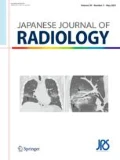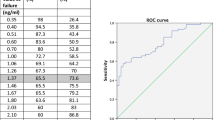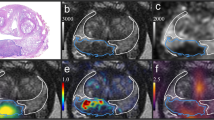Abstract
Purpose
The aim of this study was to evaluate the accuracy of 11C-choline positron emission tomography/computed tomography (PET/CT) in restaging patients affected by prostate cancer and suspected relapse due to prostate-specific antigen (PSA) increase. We also aimed to determine a PSA cutoff that is most suited to the study in terms of best compromise between sensitivity and specificity. Secondary endpoints were a comparison between 11C-choline PET/CT and histological results, clinical findings, and radiological imaging (CT and magnetic resonance imaging).
Materials and methods
We retrospectively evaluated 210 patients (median ± SD age 70 ± 7 years) affected by prostate cancer who underwent 11C-choline PET/CT.
Results
11C-choline PET/CT imaging was positive in 116 (55.2%) patients and negative in 94 (44.8%). Receiver operating characteristic (ROC) analysis showed that the highest accuracy (sensitivity 76.8%, specificity 92.5%) for the whole population was achieved when the PSA level of 1.26 ng/ml level was used as the cutoff value for interpreting the results (P = 0.0001 and the area under the ROC curve AUC 0.897). For patients treated with surgery or surgery plus radiotherapy the cutoff was 0.81 ng/ml (sensitivity 73.2%, specificity 86.1%). For patients treated with radiotherapy alone, the cutoff was 2.0 ng/ml (sensitivity 81.8%, specificity 92.9%).
Conclusion
Our results indicate that 11C-choline PET/CT is a useful diagnostic tool in patients affected by prostate cancer and a relapsed PSA level. The highest accuracy for all patients is obtained with a PSA cutoff level of 1.26 ng/ml, above which the imaging study is performed (0.81 ng/ml for patients treated with surgery or surgery plus radiotherapy and 2.0 ng/ml for patients treated with radiotherapy alone).
Similar content being viewed by others
References
Shariat SF, Scardino PT, Lilja H. Screening for prostate cancer: an update. Can J Urol 2008;15:4363–4374.
Lin AM, Small EJ. Prostate cancer update: 2007. Curr Opin Oncol 2008;20:294–299.
Jadvar H, Alavi A. Role of imaging in prostate cancer. PET Clin 2009;4:135–138.
Lin GA, Aaronson DS, Knight SJ, Carroll PR, Dudley RA. Patient decision aids for prostate cancer treatment. a systematic review of the literature. CA Cancer J Clin 2009;59:379–390.
D’Amico AV, Whittington R, Malkowicz SB, Schultz D, Blank K, Broderick GA, et al. Biochemical outcome after radical prostatectomy, external beam radiation therapy, or interstitial radiation therapy for clinically localized prostate cancer. JAMA 1998;280:969–974.
Cooperberg PMR, Broering JM, Kantoff PW, Carroll PR. Contemporary trends in low risk prostate cancer: risk assessment and treatment. J Urol 2007;178:S14–S19.
Bill-Axelson A, Holmberg L, Filén F, Ruutu M, Garmo H, Busch C, et al. Radical prostatectomy versus watchful waiting in localized prostate cancer: the Scandinavian prostate cancer group-4 randomized trial. J Natl Cancer Inst 2008;100:1144–1154.
Wilt TJ, MacDonald R, Rutks I, Shamliyan TA, Taylor BC, Kane RL. Systematic review: comparative effectiveness and harms of treatments for clinically localized prostate cancer. Ann Intern Med 2008;148:435–448.
Droz JP, Balducci L, Bolla M, Emberton M, Fitzpatrick JM, Joniau S, et al. Background for the proposal of SIOG guidelines for the management of prostate cancer in senior adults. Crit Rev Oncol Hematol 2010;73:68–91.
Testa C, Schiavina R, Lodi R, Salizzoni E, Corti B, Farsad M, et al. Prostate cancer: sextant localization with PMR imaging, PMR spectroscopy, and 11C-choline PET/CT. Radiology 2007;244:797–806.
Jemal A, Murray T, Ward E, Samuels A, Tiwari RC, Ghafoor A, et al. Cancer statistics, 2005. CA Cancer J Clin 2005;55:10–30.
Chism DB, Hanlon AL, Horwitz EM, Feigenberg SJ, Pollack A. A comparison of the single and double factor high-risk models for risk assignment of prostate cancer treated with 3D conformal radiotherapy. Int J Radiat Oncol Biol Phys 2004;59:380–385.
Catalona WJ, Smith DS, Ratliff TL, Basler JW. Detection of organ-confined prostate cancer is increased through prostatespecific antigen-based screening. JAMA 1993;270:948–954.
Dotan ZA. Bone imaging in prostate cancer. Nat Clin Prac Urol 2008;5:434–444.
Modoni S, Calo E, Nardella G, Ritrovato G, Frusciante V. PSA and bone scintigraphy. Int J Biol Markers 1997;12:158–161.
Lee CT, Oesterling JE. Using prostate-specific antigen to eliminate the staging radionuclide bone scan. Urol Clin North Am 1997;24:389–394.
Vees H, Buchegger F, Albrecht S, Khan H, Husarik D, Zaidi H, et al. (18)F-choline and/or (11)C-acetate positron emission tomography: detection of residual or progressive subclinical disease at very low prostate-specific antigen values (<1 ng/mL) after radical prostatectomy. BJU Int 2007;99:1415–1420.
Krause BJ, Souvatzoglou M, Tuncel M, Herrmann K, Buck AK, Praus C, et al. The detection rate of [(11)C]choline-PET/CT depends on the serum PSA-value in patients with biochemical recurrence of prostate cancer. Eur J Nucl Med Mol Imaging 2008;35:18–23.
De Jong IJ, Pruim J, Elsinga PH, Vaalburg W, Mensink HJ. [11C]choline positron emission tomography for the evaluation after treatment of localized prostate cancer. Eur Urol 2003;44:32–38.
Cimitan M, Bortolus R, Morassut S, Canzonieri V, Garbeglio A, Baresic T, et al. [18F]fluorocholine PET/CT imaging for the detection of recurrent prostate cancer at PSA relapse: experience in 100 consecutive patients. Eur J Nucl Med Mol Imaging 2006;33:1387–1398.
Heinisch M, Dirisamer A, Loidl W, Stoiber F, Gruy B, Haim S, et al. Positron emission tomography/computed tomography with F-18-fluorocholine for restaging of prostate cancer patients: meaningful at PSA < 5 ng/ml? Mol Imaging Biol 2006;8:43–48.
Husarik DB, Miralbell R, Dubs M, John H, Giger OT, Gelet A, et al. Evaluation of [(18)F]-choline PET/CT for staging and restaging of prostate cancer. Eur J Nucl Med Mol Imaging 2008;35:253–263.
Giovacchini G, Picchio M, Coradeschi E, Bettinardi V, Gianolli L, Scattoni V, et al. Predictive factors of [(11)C] choline PET/CT in patients with biochemical failure after radical prostatectomy. Eur J Nucl Med Mol Imaging 2010;37:301–309.
Castellucci P, Fuccio C, Nanni C, Santi I, Rizzello A, Lodi F, et al. Influence of trigger PSA and PSA kinetics on 11C-choline PET/CT detection rate in patients with biochemical relapse after radical prostatectomy. J Nucl Med 2009;50:1394–1400.
Richter JA, Rodríguez M, Rioja J, Peñuelas I, Martí-Climent J, Garrastachu P, et al. Dual tracer 11C-choline and FDG-PET in the diagnosis of biochemical prostate cancer relapse after radical treatment. Mol Imaging Biol 2010;12:210–217.
Breeuwsma AJ, Pruim J, van den Bergh AC, Leliveld AM, Nijman RJ, Dierckx RA, et al. Detection of local, regional, and distant recurrence in patients with PSA relapse after external-beam radiotherapy using (11)C-choline positron emission tomography. Int J Radiat Oncol Biol Phys 2010;77:160–164.
García JR, Soler M, Blanch MA, Ramírez I, Riera E, Lozano P et al. PET/CT with (11)C-choline and (18)F-FDG in patients with elevated PSA after radical treatment of a prostate cancer. Rev Esp Med Nucl 2009;28:95–100.
Coleman R, DeGrado T, Wang S, Baldwin S, Orr M, Reiman R, et al. Preliminary evaluation of F-18 fluorocholine (FCH) as a PET tumor imaging agent. Clin Positron Imaging 2000;3:147.
Schilling D, Schlemmer HP, Wagner PH, Böttcher P, Merseburger AS, Aschoff P, et al. Histological verification of 11C-choline-positron emission/computed tomography-positive lymph nodes in patients with biochemical failure after treatment for localized prostate cancer. BJU Int 2008;102:446–451.
Scattoni V, Picchio M, Suardi N, Messa C, Freschi M, Roscigno M, et al. Detection of lymph-node metastases with integrated [11C]choline PET/CT in patients with PSA failure after radical retropubic prostatectomy: results confirmed by open pelvic-retroperitoneal lymphadenectomy. Eur Urol 2007;52:423–429.
Author information
Authors and Affiliations
Corresponding author
About this article
Cite this article
Bertagna, F., Abuhilal, M., Bosio, G. et al. Role of 11C-choline positron emission tomography/computed tomography in evaluating patients affected by prostate cancer with suspected relapse due to prostate-specific antigen elevation. Jpn J Radiol 29, 394–404 (2011). https://doi.org/10.1007/s11604-011-0570-1
Received:
Accepted:
Published:
Issue Date:
DOI: https://doi.org/10.1007/s11604-011-0570-1




